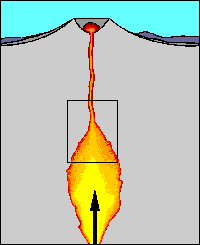Monitoring: | Gas | Ground Deformation | Hydrologic | Remote Sensing | Seismicity |
![]()
![]()
![]()
![]()
Monitoring: | Gas
| Ground
Deformation
| Hydrologic
| Remote
Sensing
| Seismicity |
![]()
 |
 |
 |
|
Earthquake activity beneath a volcano almost always increases before an eruption because magma and volcanic gas must first force their way up through shallow underground fractures and passageways. When magma and volcanic gases or fluids move, they will either cause rocks to break or cracks to vibrate. When rocks break high-frequency earthquakes are triggered. However, when cracks vibrate either low-frequency earthquakes or a continuous shaking called volcanic tremor is triggered. Most volcanic-related earthquakes are less than a magnitude 2 or 3 and occur less than 10 km beneath a volcano. The earthquakes tend to occur in swarms consisting of dozens to hundreds of events. During such periods of heightened earthquake activity, scientists work around the clock to detect subtle and significant variations in the type and intensity of seismic activity and to determine when an eruption is occurring, especially when a volcano cannot be directly observed. |
||
| Home |
U.S. volcano activity | World volcano activity |
Photo glossary |
Highlights |
| Search this site |
Site index |
Volcano observatories |
Educator's page |